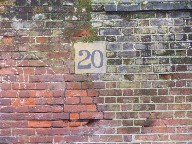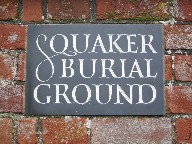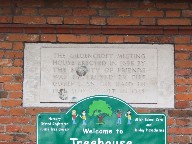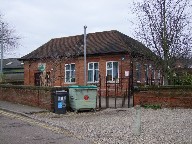| |
|
Friends
Meeting House, Gildencroft, Norwich
 |
|
This
part of Norwich has suffered as badly from
post-war reconstruction as it ever did from
German bombs, but this building's current
appearance can be laid fairly and squarely at the
feet of the Luftwaffe. This was the site of the
city's original Meeting House for Friends, built
in 1699 for a denomination only just emerging
from the persecution of both the Commonwealth and
Restoration. A church loathed by both Puritans
and Anglicans must have something going for it,
and the Quaker community of Norwich would become
a significant one, producing bankers, architects,
philanthropists and reformers. Even today,
Quakers are considered an important part of the
Norwich historical and spiritual landscape. This chapel
was superceded in the 1820s by a grand structure
nearer to the centre of the city, but remained in
use. Bill Wilson, in the revised Buildings of
England: Norfolk describes it as one of
the largest and stateliest of the Quaker Meeting
Houses, and suggests that it was built along
the lines of the Old Meeting House in Colegate.
|
To be
honest, it is hard to believe that anything on that scale
ever stood here, and a visit there may cause you to mourn
for what is here now, because, as a plaque reminds us,
Norwich Old Quaker Meeting House was destroyed
in the fire storm of the Norwich Blitz in 1942. Although
rebuilt in 1956, what we see today speaks entirely
of post-war municipalism. The one saving grace is that
the old Quaker graveyard to the east survives, and,
indeed, is still in use today, uniquely in central
Norwich. I must say that I find it a moving experience to
wander among the still, silent graves, particularly as
the old Quaker graveyard in Ipswich is currently being
built over for a new hotel.
The
Quakers no longer worship here. Today, it is a day
nursery. Part of the graveyard has become a playground,
although the bold numbers on the wall denoting rows of
graves survive.
| If
Germans are to be blamed for the appearance of
the chapel, its redundancy can be laid fairly and
squarely at the feet of an East Anglian. Against
all advice, and against the intention of the
post-war Norwich Plan, the inner-ring road was
rerouted several hundred metres south of its
intended route by City Engineer Herbert Rowley in
the 1960s. Instead of following the line of the
city walls, it cuts off a part of the medieval
city from the rest; that part, unfortunately,
includes Gildencroft. To add
insult to injury, Rowley allowed the stupefyingly
ugly Sovereign House and Anglia Square to be
built on this part of the medieval city, and
today you really wouldn't know that the part of
Norwich immediately north of the inner ring had
ever been anything other than a rather gloomy
suburb. Inevitably, the Quakers of Norwich
prefered to use their central meeting house on
Upper Goat Lane, and this building was sold off.
But who can visit it without at least a frisson
for the passions of the past?
|
|
 |
|
|
|


